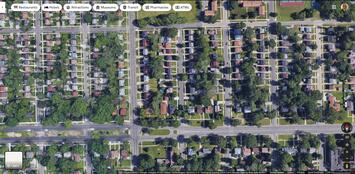
About a month ago I asked a simple question on Twitter, hoping to get Urbanist Twitter’s consensus opinion. I posted an aerial picture of a residential neighborhood (see above) and asked, “is this urban?” I was quite surprised by the responses.
I removed place names, streets and other giveaways so people would have at least some difficulty nailing down the location. I also gave a few details that could help with a decision – primarily single-family homes on 40-foot-wide lots, each with driveways and detached garages. An apartment complex that can be seen in the upper right of the photo, and a street on the left side lined with attached duplexes. A commercial strip about two blocks south of the picture’s center. No alleys.
I wanted to add a poll but couldn’t add a poll and a picture in the same tweet. But it’s also true I didn’t want to pigeonhole any responses, giving responders their opportunity to explain. But when I did my analysis of results after 56 comments I couldn’t believe what I saw: 43% said definitely suburban, 21% I classified as “leans urban”, and 18% said either definitely urban or could be “leans suburban”.
Why was I surprised at the results? Because the aerial photo was of the neighborhood I grew up in on Detroit’s Northwest Side. I’d always considered it urban, even if it wasn’t that in the dense New York City sense. To me, it was definitely not suburban.
A lot of responders nailed the neighborhood character – narrow-lot single-family homes arranged on a grid, built following World War II. Others quickly nailed the city, a handful even nailed the exact area. But even as they agreed on character, they disagreed on neighborhood type. Was the neighborhood "urban or "suburban"? On the urban side:
- "Definitely urban, judging from street plan"
- "I say urban because if it was suburban, then streets with rows of houses would be blocked off from the main road and they would not be in a grid pattern."
- "What’s the scale of those lots? That looks like a pretty dense single-unit neighborhood. Definitely urban."
And then on suburban side:
- "I’m not seeing any commercial (not even a corner store). Looks firmly suburban to me, regardless of the political jurisdiction it’s in."
- "100%. Grass, single family homes, driveways, detached. This is the definition of suburbia. What’s the case for urban?!?"
- "Primarily single family homes, single-use neighborhood, driveways and multiple car parking spaces per home all point to suburban-style development even if it's near the city core."
Clearly, what is considered urban or suburban is in the eye of the beholder. Just like the U.S. Supreme Court Justice Potter Stewart said about "obscenity" in the Jacobellis v. Ohio case in 1964, "I know it when I see it." But maybe we should develop some consensus what exactly is or isn't urban (and suburban), based on a uniquely American standard, so we can speak the same language on this.
Read the rest of this piece at Corner Side Yard Blog.
Pete Saunders is a writer and researcher whose work focuses on urbanism and public policy. Pete has been the editor/publisher of the Corner Side Yard, an urbanist blog, since 2012. Pete is also an urban affairs contributor to Forbes Magazine’s online platform. Pete’s writings have been published widely in traditional and internet media outlets, including the feature article in the December 2018 issue of Planning Magazine. Pete has more than twenty years’ experience in planning, economic development, and community development, with stops in the public, private and non-profit sectors. He lives in Chicago.
Image: Google map, satellite view.












